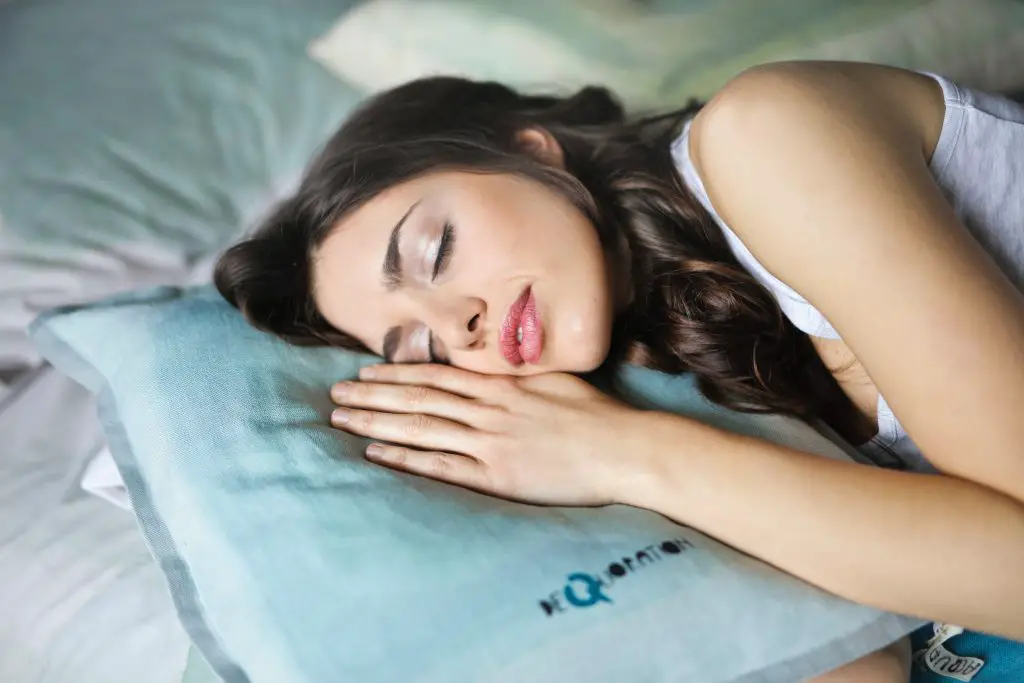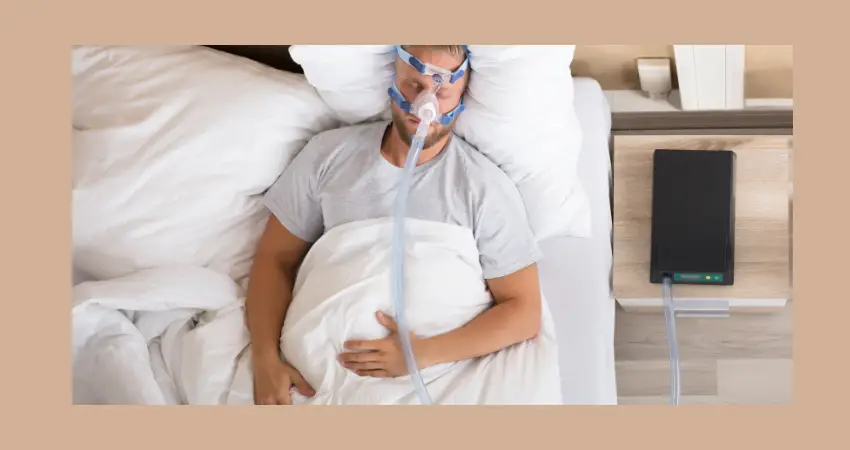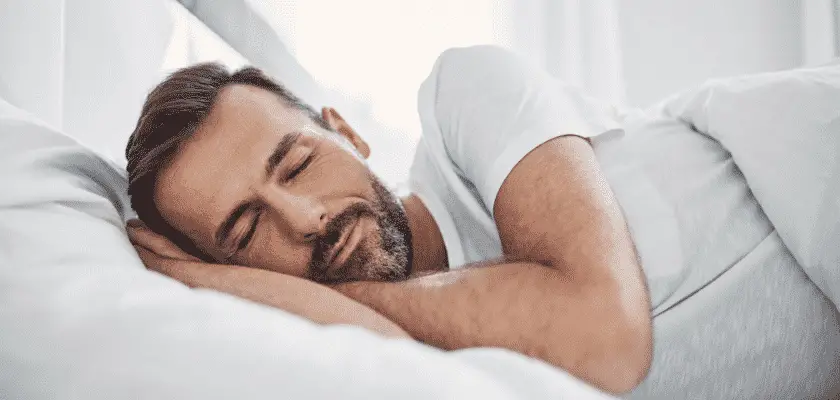Sleep Apnea is a condition in which disturbed breathing interrupts sleep. It’s one of the most common medical conditions in adults, affecting up to 5% of women and 15% of men between the ages of 30 and 60.
The Difference Between Snoring and Sleep Apnea
Most people suffering from sleep apnea also snore, but there’s a big difference between the two conditions. While snoring can be annoying, sleep apnea can be life-threatening.
During an apnea episode, the body’s oxygen levels can drop noticeably, carbon dioxide can build up, and the heart will have to work harder to cope.
Each time it happens, the brain sends a wake-up signal so that the person can breathe, and this means never getting a good night’s sleep.
There are Three Types of Sleep Apnea
Obstructive sleep apnea (OSA), the most common type, happens when air cannot get into the lungs because the upper airway has collapsed.
It’s more common in men and in people who are overweight, especially those who sleep on their backs. In people of normal weight who have the condition, there’s often an abnormality in the lower face, such as having a small chin, an overbite, or a large tongue. Obstructive sleep apnea typically has three phases:
- First, the airway is partly blocked as the soft tissue at the back of the throat relaxes and starts to close up, causing very loud snoring.
- Eventually, the airway collapses and the person stops breathing for at least 10 seconds and up to 2 minutes.
- Finally, the sufferer wakes up briefly (although they are rarely aware of it), struggling to breathe, snorting or gasping for air.
- Once a breath is taken, however, the person falls back asleep and the cycle repeats itself.
Central sleep apnea, which is quite rare, results when the brain fails to send signals to the chest to breathe properly while asleep. Here too, however, the person ends up waking repeatedly during the night to breathe.
Mixed sleep apnea, as the name suggests, is a combination of the first two types. It always starts out as central sleep apnea, and then turns into OSA.

Symptoms and Complications of Sleep Apnea
Unfortunately, most people with sleep apnea don’t even know they have it. Over 10 million Americans are thought to have undiagnosed sleep apnea. The American Sleep Apnea Foundation has come up with a simple quiz to help people find out if they have sleep apnea. Anyone who answers “yes” to any of the following questions should talk to a doctor:
- Are you a loud, habitual snorer?
- Do you feel tired and groggy when you wake up?
- Are you often sleepy during the day?
- Are you overweight?
- Are you known to choke, gasp, or hold your breath while asleep? You may want to ask your partner about this.
Daytime sleepiness is probably the most important symptom that patients notice, since it can make it hard to stay awake, concentrate and work. People can even end up losing their jobs if they’re always nodding off during the day.
An especially dangerous problem is drowsiness while driving or operating machinery – people with sleep apnea get into more accidents than average.
It’s best for people with sleep apnea to avoid driving if they feel sleepy, or to stop driving completely until the sleep apnea is under control.
Sleep apnea can also lead to headaches, memory problems, and depression.
In severe cases, complications including high blood pressure, heart attacks, strokes, and abnormalities in heart function such as heart failure and arrhythmias (irregular heartbeat) can develop or worsen due to sleep apnea.
Most people suffering from sleep apnea also snore, but there’s a big difference between the two conditions. While snoring can be annoying, sleep apnea can be life-threatening.
During an apnea episode, the body’s oxygen levels can drop noticeably, carbon dioxide can build up, and the heart will have to work harder to cope.
Each time it happens, the brain sends a wake-up signal so that the person can breathe, and this means never getting a good night’s sleep
Making the Diagnosis of Sleep Apnea
A doctor will ask more detailed questions to find out whether someone has the symptoms of sleep apnea and will examine them physically to see what might be blocking the airway.
Routine blood tests, blood pressure readings, and examinations of the heart might be done to see if there are physical complications from sleep apnea or to rule out other possible conditions.
To confirm that the condition is sleep apnea, however, a test called overnight polysomnography may be done.
For this test, a variety of measurements are taken while the person sleeps in a specialized sleep laboratory.
Medications for Sleep Disorders
Sleep apnea is a condition that is associated with interruptions to breathing during sleep. This is a common disorder that affects millions of people all around the world.
This can be very scary for the person who suffers as well as their family. The problem is that many people who suffer are not even aware that they have sleep apnea.
There are different types of sleep apnea that one can suffer from. The most common type of sleep apnea is obstructive sleep apnea.
Obstructive sleep apnea occurs when too little air gets in the lungs through the mouth and nose. As a result of this lack of oxygen, the oxygen in the blood drops too low and the body cannot function the way it should.
Treatment Methods for Sleep Apnea
There are a few different treatment methods that are used to treat apnea, but medication for sleep apnea has been the most effective for most patients.
In fact, the medication for apnea has been so effective that it is the most popular treatment course.
Modafinil is the most commonly used medication for sleep apnea today. This is a pill that is taken once a day and helps to decrease the tiredness that is caused by apnea during the day. It affects the chemicals in the brain to help with alertness and memory.
There are some side effects that you should be aware of such as headache, nausea, nervousness, anxiety, upset stomach, dizziness, and back pain. If you are taking this medication, and you begin to experience these problems, you need to contact your doctor.
This medication is a very common treatment, but doctors will not usually try this if other options have been tried beforehand. You need to go to the doctor and be honest with him or her about how you are feeling and what you have tried.
Sleep apnea is a frightening and even inconvenient condition, but with treatment, it doesn’t need to be anything that impacts your life in a negative way.
Just make sure that you work as closely as possible with your doctor so that your life with apnea is as productive as possible.
CPAP Machine
Continuous positive airway pressure or CPAP is the gold standard for treating sleep apnea.
The biggest complaints I hear from researchers believe that using continuous positive airway pressure or CPAP which is a therapy often used in the treatment of sleep apnea, it would also indirectly aid in improving diabetes.
Thus, for those having a sleep apnea diabetes condition, CPAP will do more than simply improve breathing patterns because it also helps to control the level of glucose in the blood.
You should talk to your doctor about whether this is an option for you!
CPAP stands for Continuous Positive Airway Pressure, and it is a common treatment for sleep apnea, a sleep disorder characterized by pauses in breathing or shallow breaths during sleep. CPAP machines work by delivering a constant flow of air pressure to keep the airways open and prevent obstruction.
Here’s how CPAP work in a simple and easy-to-understand way:
-
Keeping the Airway Open: When you sleep, the muscles in your throat can relax and cause the airway to narrow or collapse. This leads to interruptions in breathing, which disrupts your sleep. A CPAP machine uses a mask that fits over your nose and/or mouth and gently blows air into your airway, keeping it open throughout the night.
-
Improved Sleep Quality: By maintaining a steady and constant flow of air pressure, CPAP helps prevent the airway from collapsing or becoming blocked. This allows you to breathe freely and continuously, reducing interruptions in your sleep. As a result, CPAP can greatly improve the quality of your sleep and help you wake up feeling more refreshed and energized.
-
Benefits beyond Sleep Apnea: While CPAP is primarily used for treating sleep apnea, it can offer additional benefits as well. Since it promotes better sleep, it can help alleviate symptoms related to sleep deprivation, such as daytime fatigue, poor concentration, and mood disturbances. By improving sleep quality, CPAP may also have positive effects on overall health and well-being.
-
Who Can Benefit: While CPAP is most commonly prescribed for people with sleep apnea, it may also benefit individuals who experience snoring, upper airway resistance syndrome (UARS), or other sleep-related breathing disorders. CPAP can be tailored to individual needs, and the air pressure settings can be adjusted based on the severity of the condition and the person’s comfort level.

When using a CPAP machine, it’s important to consider certain safety precautions. Here are some key safety considerations associated with CPAP therapy:
- Proper Use and Maintenance: It’s crucial to follow the manufacturer’s instructions and guidelines for setting up, using, and maintaining your CPAP machine. This includes properly assembling the equipment, correctly fitting the mask, and regularly cleaning and replacing the necessary components as recommended. Adhering to these instructions helps ensure the optimal performance and safety of the device.
- Electrical Safety: CPAP machines are electrical devices that require a power source. To ensure safety, it’s essential to use the provided power cord and adapter specifically designed for your CPAP machine. Avoid using damaged or frayed cords, and make sure to plug the machine into a grounded electrical outlet. If you experience any electrical issues, contact the manufacturer or a qualified technician for assistance.
- Mask Fit and Comfort: The mask is a crucial component of CPAP therapy, and it’s important to find a mask that fits properly and is comfortable to wear. A poorly fitted mask can cause air leaks, skin irritation, or discomfort. Work with a healthcare professional or CPAP supplier to find the right mask size and style for your individual needs. Regularly inspect the mask for wear and tear, and replace it if necessary to maintain a proper seal.
- Cleaning and Hygiene: Regular cleaning of CPAP equipment is essential to prevent the buildup of bacteria, mold, and other contaminants. Follow the manufacturer’s instructions for cleaning the mask, tubing, and humidifier components. Use mild, non-fragrant soap and warm water for cleaning, and ensure that all components are thoroughly dried before reassembling the equipment. Regular cleaning helps maintain the hygiene and effectiveness of your CPAP therapy.
- Humidifier Safety: Some CPAP machines come with built-in humidifiers to add moisture to the air being delivered. If you use a humidifier, make sure to clean and refill it with distilled water regularly. Using tap water or failing to clean the humidifier can lead to the growth of bacteria or mineral deposits, which can pose health risks. Always follow the manufacturer’s instructions for proper use and maintenance of the humidifier.
- Travel Considerations: If you plan to travel with your CPAP machine, familiarize yourself with the transportation guidelines of the airline or mode of transport you’ll be using. Some airlines allow CPAP machines in carry-on bags, but it’s advisable to check in advance. Additionally, consider using a travel-friendly CPAP machine that is compact and lightweight for convenience.
Remember, it’s important to consult with a healthcare professional or your CPAP supplier for personalized advice and guidance regarding safety considerations specific to your CPAP therapy.
In summary, CPAP machines work by delivering a steady flow of air pressure to keep the airway open during sleep. By preventing obstructions and interruptions in breathing, CPAP can greatly improve sleep quality, reduce daytime fatigue, and enhance overall well-being. While primarily used for sleep apnea, CPAP may also benefit individuals with other sleep-related breathing disorders. It is important to consult with a healthcare professional to determine if CPAP therapy is suitable for your specific needs.

